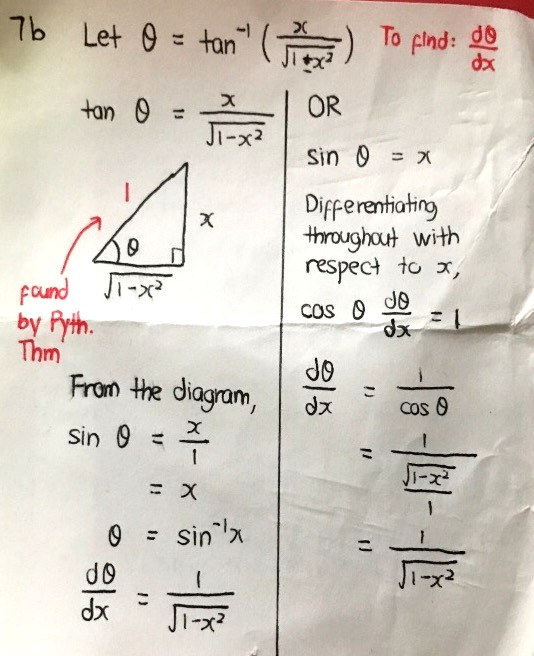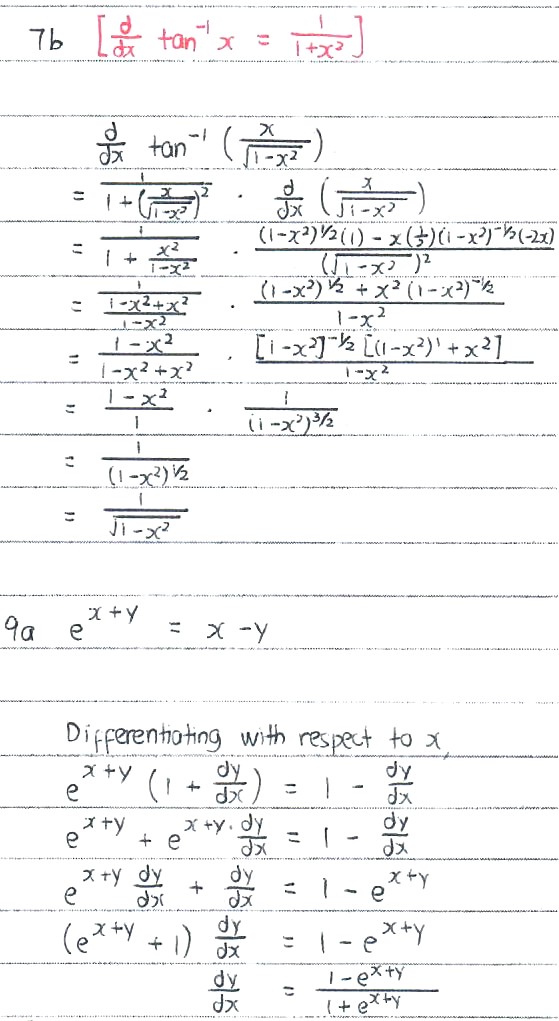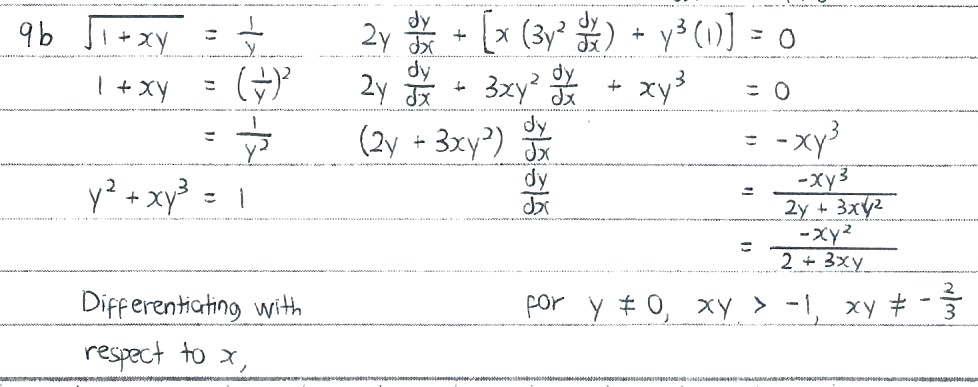Ask Singapore Homework?
Upload a photo of a Singapore homework and someone will email you the solution for free.

Question
junior college 1 | H2 Maths
3 Answers Below
Anyone can contribute an answer, even non-tutors.

In need of help for question 7(b) and question 9. Please help Thank you!!!!
d/dx ( tan‾¹ (x/√(1 - x²) )
= d/dx (tan‾¹ (x(1 - x²)-¹⁄²)
= 1/(1 + (x(1 - x²)-¹⁄²)² ) × (d/dx (x(1 - x²)-¹⁄²) )
= 1/(1 + x²(1 - x²)-¹ ) × ((1 - x²)-¹⁄² + x(-2x)(-½)(1 - x²)-³⁄² )
= 1/( (1-x²)-¹((1 - x²) + x²) ) × ( (1 - x²)-¹⁄² + x²(1 - x²)-³⁄² )
= 1/(1 - x²)-¹(1) × ( (1 - x²)-³/² ((1 - x²)+ x²) )
= (1 - x²) × (1-x²)-³⁄² (1)
= (1 - x²)¹-³⁄²
= (1 - x²)-¹⁄²
= 1/√(1 - x²)
e^(x + y) = x - y
Differentiate both sides with respect to x,
(1 + (1)dy/dx ) e^(x + y) = 1 - (1)dy/dx
e^(x + y) + e^(x + y) dy/dx = 1 - dy/dx
e^(x + y) dy/dx + dy/dx = 1 - e^(x + y)
dy/dx (e^(x + y) + 1) = 1 - e^(x + y)
dy/dx = (1 - e^(x + y) )/(1 + e^(x + y) )
Let y = tan‾¹ (x/√(1 - x²) )
Then tan y = (x/√(1 - x²) )
Differentiate both sides with respect to x,
sec²y (dy/dx) = ((1 - x²)-¹⁄² + x(-2x)(-½)(1 - x²)-³⁄² )
(1/cos y) dy/dx = ( (1 - x²)-¹⁄² + x²(1 - x²)-³⁄² )
dy/dx = (1 - x²)-³⁄² ((1 - x²)+ x²) ) cos y
dy/dx = (1-x²)-³⁄² (1)cos y
dy/dx = (1 - x²)-³⁄² (√(1- x²)/1)
= (1 - x²)-³⁄²+¹⁄²
= (1 - x²)-¹⁄²
= 1/√(1 - x²)
You may be wondering how did cos y get converted to √(1- x²)/1.
This is actually done by considering a right angled triangle with a designated angle y, with hypotenuse as 1, the opposite side as x, the adjacent as √(1 - x²)
(Based on tan y = (x/√(1 - x²) ) , so adj = x and opp = √(1 - x²)
Based on Pythagoras' Theorem we can say
adj² + opp² = hyp²
adj² = hyp² - opp² = 1² - x²
adj = √(1 - x²)
cos y = adj/hyp = √(1 - x²)/1
Since we are essentially differentiating
angle y when differentiating tan‾¹(x/√(1 - x²) ),
We can have a third alternative by restating it as differentiating sin‾¹(x/1) as it gives us the same angle y
sin‾¹(x/1) is just sin‾¹(x), which easily differentiates to 1/√(1 - x²) as you would have already learnt.
To make things easier, square both sides.
1 + xy = 1/y² = y‾²
Differentiate both sides wrt x,
y + x dy/dx = -2y‾³ dy/dx = -2/y³ dy/dx
x dy/dx + 2/y³ dy/dx = -y
(x + 2/y³)dy/dx = -y
dy/dx = -y/(x + 2/y³)
= -y⁴/(xy³ + 2)
Alternately,
√(1 + xy) = 1/y
Differentiate both sides wrt x,
½(1 + xy)‾¹⁄² (y + x dy/dx) = -1/y² dy/dx
y/(2√(1 + xy) ) + x/(2√(1 + xy) )dy/dx = -1/y² dy/dx
-y/(2√(1 + xy) ) = 1/y² dy/dx + x/(2√(1 + xy) )dy/dx
-y/(2√(1 + xy) ) = dy/dx (x/(2√(1 + xy) ) + 1/y²)
dy/dx = -y/(2√(1 + xy) ) × 1/(x/(2√(1 + xy) ) + 1/y²)
dy/dx = -y/( (2√(1 + xy) ) × 1/( (xy² + 2√(1 + xy) ) /(2y²√(1 + xy) ) )
dy/dx = -y/( (2√(1 + xy) ) × 2y²√(1 + xy) / ( xy² + 2√(1 + xy) )
= -y³/ (xy² + 2√(1 + xy) )
See 3 Answers
These are the alternative workings for Q7b by direct differentiation.
Q9a requires you to use chain rule for differentiation with respect to x. Since y is a function of x, it also gets differentiated to dy/dx (implicitly, which arises from the chain rule).
Q9b also requires a similar idea, which I will post next.







